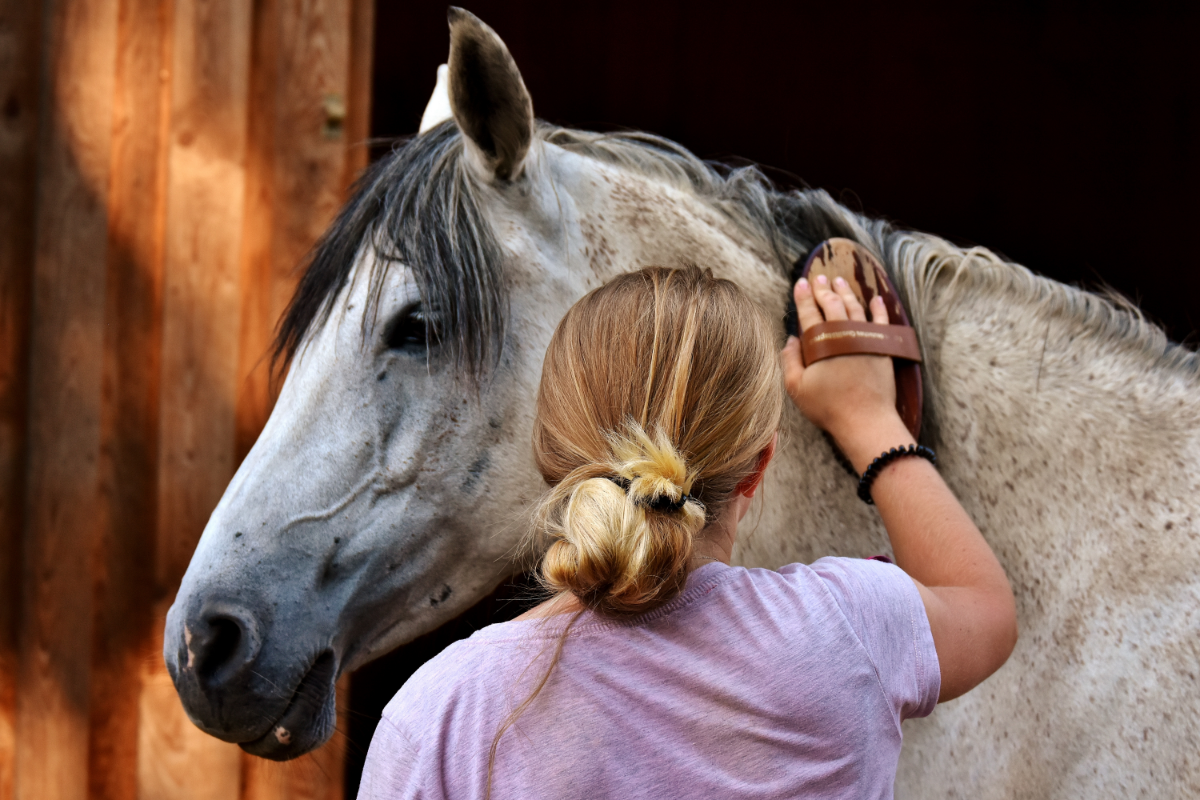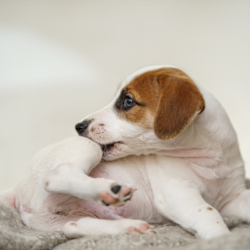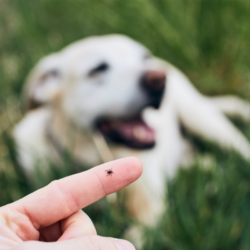All living beings are exposed to parasites. In particular, they infect pets and livestock. They are many and varied: from ticks to fleas, from tapeworms to parasitic flies. The host and the parasites can coexist without necessarily harming each other. A balance between the two living beings is possible. However, if this balance is upset, parasitic infections can occur. The consequences are numerous and can disrupt your pet’s behaviour. Our friends the horses are the most vulnerable to this.
External parasites of horses
Equidae are very sensitive to parasites. Whether these are inside the body, such as endoparasites, or outside: ectoparasites. The latter are categorised into two very distinct species: ticks and flies.
Ticks
Ticks are arachnids common in the wild. They feed on blood by attaching themselves to a host and can transmit diseases. In horses, ticks can cause problems such as anaemia and various systemic diseases.
They infest horses and other species and are present throughout France. They spend around a week on their host feeding on blood, increasing in size from a few millimetres to 2 cm, before returning to the wild to reproduce in large numbers.
Ticks are mainly found outside stables, in shrubs and tall grass. Horses pick them up on walks or while out in the pasture or paddock. These parasites hunt in ambush from high places and drop onto their prey as soon as they detect vibrations from the ground or branches. It is important to note that juvenile ticks, which are almost invisible to the naked eye, spend around 48 hours looking for the best place on the horse’s body to implant themselves firmly and feed on blood. After a week or so of feeding, they detach, gorged with blood, to lay their eggs in the wild.
Risks to horses include blood loss in the event of massive infestation, although this is rare, except in the case of neglected horses. The bite itself is not serious, but some ticks, not all, can transmit diseases when bitten. These tick-borne diseases include piroplasmosis, Lyme disease, equine anaplasmosis, equine infectious encephalitis and equine haemorrhagic fever. Symptoms vary depending on the disease and can include fever, lethargy, loss of appetite, jaundice, stiffness, arthritis and other ailments.
Parasitic flies
Horses are also prey to parasitic flies. These insects generally invade your horse’s environment. As well as proliferating in its living space, the parasitic fly greatly disturbs your horse’s daily life, even altering its behaviour. The most common parasitic flies in horses are : Horse flies, gasterophilus flies and anthrax flies. These parasitic diptera are generally haematophagous. In other words, this type of fly feeds on the blood of its host. Their incessant bites have a major impact on the condition of your horses. As well as causing constant stress, they can carry parasitic diseases.
Horse flies
The horsefly, also known as the horse fly, is a flying insect belonging to the Tabanidae family. They are characterised by their relatively large size, bright eyes and colourful patterns. These insects are active during the warmer months of the year, generally from spring to autumn, and feed on the blood of various animals, including horses.
Contrary to what you might think, horseflies do not sting, but they do bite. The difference between a sting and a bite is significant: when an insect stings, it inserts a biting organ into the skin to feed, whereas a bite involves the insect cutting the skin to reach the blood. Horseflies have sharp mouthparts that enable them to bite and create a superficial wound through which they feed.
Female horseflies, unlike males, feed on blood. Although both sexes generally feed on nectar and sweet plant substances, females need extra protein to develop their eggs. This is why they turn to the blood of animals, including horses, to satisfy this protein requirement. The males, on the other hand, do not take part in blood feeding and are content to forage on the flowers.
As well as causing pain and irritation in horses, horseflies can also transmit the Borrelia burgdorferi bacteria responsible for Lyme disease. When an infected horsefly bites a horse, the bacteria can be transmitted through the wound, leading to potential infection. Lyme disease can have serious consequences, causing symptoms such as lameness, joint problems and neurological disorders in horses.
Gaesterophilus
Gaesterophilus are winged insects that resemble large bumblebees. The females of these insects bite rather than sting and belong to the Tabanidae family. Active during the warmer months, from spring to autumn, they lay their eggs on horses’ coats. The resulting larvae develop in the horses’digestive tract, causing a condition known as digestive myiasis.
In Europe, different species of gastropods parasitise equidae. Their life cycle is similar, with a few variations. Some lay their eggs in the environment, while others deposit them on the horses’ hair. The larvae are mainly found in the stomach, duodenum or rectum.
The eggs are small, elongated, whitish elements measuring 1 to 2 mm, attached to various parts of the body, such as the limbs, head, shoulders or flanks. After hatching, the larvae move into the horse’s digestive tract, either by licking, migrating through the skin or ingesting food. They attach themselves to various parts of the digestive tract, causing superficial ulcerations in order to feed.
After a few months, the larvae are excreted in the faeces. They pupate in the soil before becoming adult gastropods.
Although common in Europe, gasterophilosis is not generally considered to be a serious disease. Most infected horses are asymptomatic, but some may develop inflammation of the mouth, gastric and intestinal ulcers or other problems. Diagnosis can be made by observing eggs on the horse’s coat, larvae in excrement, digestive endoscopy or blood/faecal tests.
Flat flies
Hippobosca equina, commonly known as the horse hippo, flat fly or spider fly, is a parasite mainly found on horses. It frequently nestles under the tail or on the inside of the thighs, moving around like a spider. Although it occasionally infests cattle and sheep, in France it is more widespread in the southern departments.
This fly has a flat, robust body, yellow and brown in colour, with a biting proboscis. Its reproduction is unique: females do not lay eggs. Instead, the larvae develop and hatch in the uterus, before being ejected to the ground as pupae. On average, one female produces 5 to 6 pupae.
The bite of the hippobosque is painful for horses, but does not appear to transmit any pathogens. Diagnosis is by direct observation, especially around the anus, the perineal region, between the thighs, the sheath or the udder.
In terms of treatment and prevention, these flies are difficult to control. They have strong claws that cling firmly to the skin. Methods include manual removal, application of repellents and use of insecticides, although prevention is difficult because the pupae reside in the environment and other animal hosts may harbour the adult parasites.
Hippobosques are dipteran insects of the family Hippoboscidae, haematophagous parasites of birds and mammals. Their etymology comes from the Greek ἱπποβοσκός (hippoboskós), meaning “that breeds horses”. Their behaviour is marked by slow flight and the ability to move diagonally across their host. They are resistant to blows and hate water, proliferating in the summer months.
Hippobosca equina is particularly found on a variety of hosts, including horses, dogs and humans. Native to Europe and North Africa, it has migrated globally with humans.
Anthrax flies
Stomoxys calcitrans, also known as stomox, biting fly, coal fly or horse phlegm fly, is a diptera in the Muscidae family. Unique in its family, it is haematophagous, feeding on the blood of mammals. This species is particularly feared in livestock farming for its ability to transmit anthrax, a serious infection.
Typically resident in rural areas and livestock structures such as stables, it lays its eggs in manure and dung, producing coprophagous larvae. As an adult, it can be recognised by its black, pointed proboscis, and is sometimes referred to as the stable fly.
The development period of the larvae varies between 10 and 80 days, depending on the temperature. In addition to anthrax, these flies are vectors of several pathogens, including equine infectious anaemia virus, African swine fever, West Nile fever and Rift Valley fever. They also transmit rickettsiae, other bacteria and parasites such as Trypanosoma spp. and Besnoitia spp. and are intermediate hosts for the nematode Habronema microstoma.
These flies are generally controlled on farms using insecticides, although less toxic alternatives such as essential oils are being explored. These flies sometimes coexist with Stomoxys niger, a closely related species that also vectors haemoparasites.
Stomoxes, measuring 6 to 8 millimetres, resemble houseflies but can be identified by their two large red and brown eyes and black legs. Their bites are painful for humans and can transmit bacterial and viral diseases. They have a significant impact on livestock farms, causing stress and economic losses. Their life cycle varies between 12 and 60 days, depending on the temperature.
Culicoides
How can I get rid of parasitic flies?
For your own good, dear rider, as well as that of our horse friends, it is essential to get rid of these flies. There are a few treatments and good practices you can use to relieve your herd of these parasites.
Flymax Derm Audevard 400ml is ideal for caring for your stallions, mares and foals. This 3-action spray effectively combats summer dermatitis caused by flies. Its formulation makes it both a repellent and a care product. Flymax Derm treats bites thanks to its soothing action on itching. This treatment repels a wide range of insects, including flies, mosquitoes, horseflies, ticks, Culicoides and other external parasites..
To complement the action of your spray, you can use ADHOC Gel Local Equine Care 600g. This gel with 100% plant-based active ingredients is designed for local application, i.e. areas prone to parasitic infestation. This treatment is dedicated to the hairless parts of your animal’s body. In other words, mares’ udders, foals’ ears and nasal passages. In fact, this gel is formulated to keep parasites of all kinds at bay. You’ll have a healthy herd!
Keep ticks away
To protect horses from ticks, it’s essential to focus on prevention. Keeping horses away from ticks is more feasible than the reverse. It is advisable to avoid scrub in paddocks, keep a distance between hedges and fences, and trim hedges to prevent branches from reaching horses. When walking in the forest, it is best to avoid brushing against branches.
Unfortunately, there are no specific anti-tick products for horses, unlike for dogs and cats. However, Dimeticone is promising. Dimeticone, a silicone oil, coats and immobilises crawling parasites such as ticks without using pesticides. It is effective in prevention, particularly in the 48 hours before a tick bites.
Getting rid of ticks on horses requires careful inspection. Ticks often attach themselves to thin-skinned areas or folds of skin. It is crucial to remove the head of the tick, which is deeply anchored in the skin, to prevent the formation of subcutaneous cysts.
Tick control is crucial given the serious diseases they can transmit to horses. Despite the difficulty of this control due to the resilience and abundant presence of ticks, prevention remains the most effective strategy.
Repelling flies
Treatment against gasterophils includes the use of effective dewormers, often included in standard deworming protocols. To prevent infestation, it is advisable to remove the eggs from the coat with a fine comb or to wash the coat with a diluted insecticide.
Measures to prevent horseflies and Lyme disease include using repellents, installing horsefly traps, avoiding infested areas and keeping the environment clean.
For flat flies, avoidance methods include manual removal,application of repellents or insecticides. However, it is not possible to completely prevent this parasite in certain regions.
Preventing RESD (recurrent equine summer dermatitis) involves avoiding Culicoides bites, by using insecticide-impregnated mosquito nets, avoiding damp meadows, and using mosquito blankets.
When choosing a fly mask for a horse, it’s important to consider the following options:
- With or without a nose guard.
- With or without ear protection.
- Full cap covering eyes, ears and nostrils.
Fly rugs for horses can protect the trunk, neck, belly, tail and other sensitive areas. It is essential to choose an appropriate size and a comfortable material. Use natural repellents based on citronella and essential oils to repel flies. Apply them frequently to maintain their effectiveness. To eliminate flies in the stable, carry out regular maintenance. This includes removing food scraps, cleaning feed troughs and using insect repellent cleaning products.







